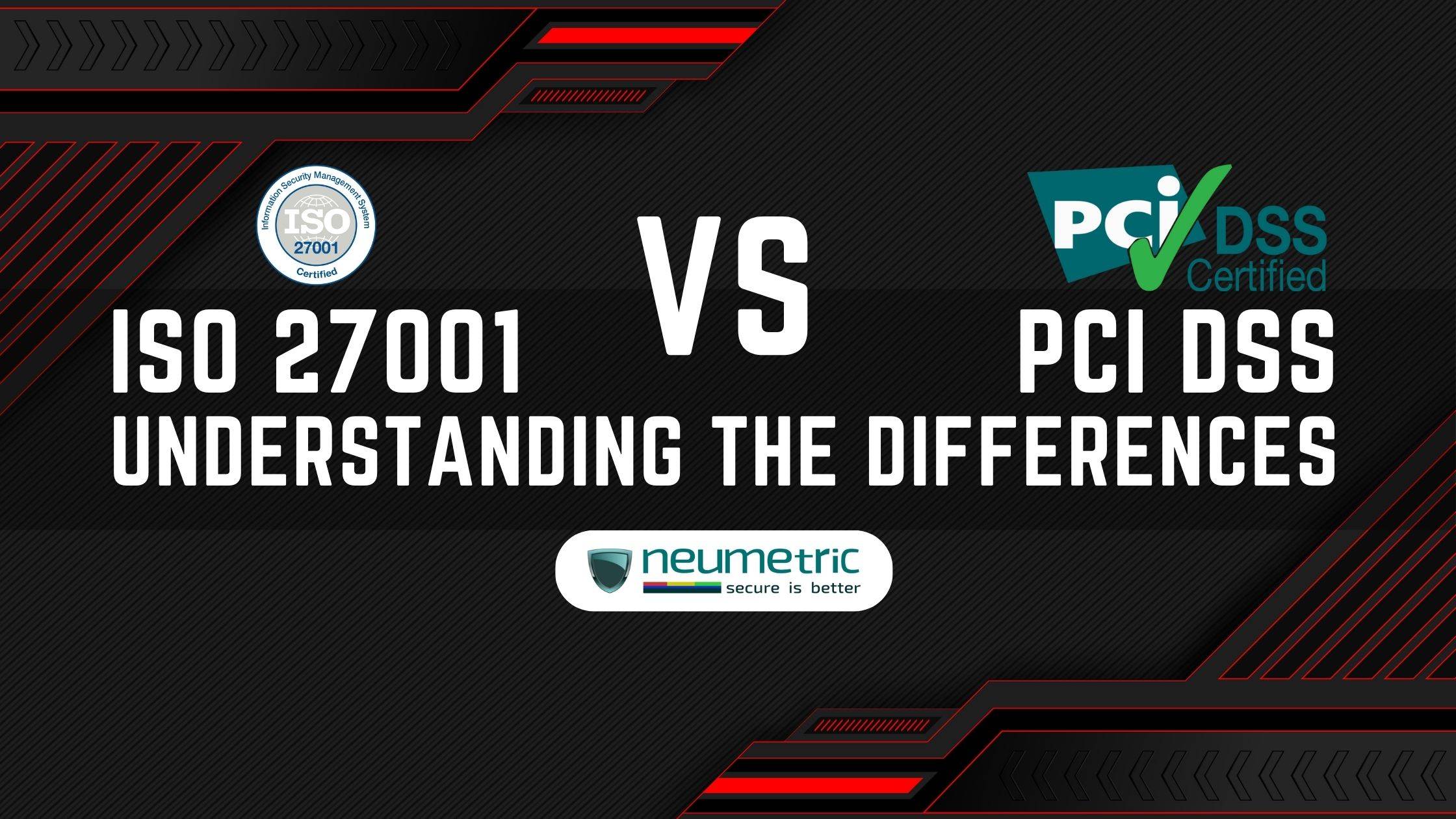Table of Contents
ToggleIntroduction
ISO 27001 is an International Standard that outlines the best practices for implementing an Information Security Management System [ISMS]. The Standard provides a systematic approach to managing sensitive Company information, ensuring its Confidentiality, Integrity & Availability. On the other hand, the Payment Card Industry Data Security Standard [PCI DSS] is a set of Security Standards designed to ensure that all Companies that accept, process, store or transmit Credit & Debit Card information maintain a secure Environment.
Both Standards place a strong emphasis on organisational & technical controls, however, PCI DSS is more rule-based whereas ISO 27001 is more risk-based. Comparing PCI DSS with ISO 27001 implies analysing a set of baseline regulations against a set of risk-based controls.
In this Journal, we will explore the differences between ISO 27001 vs PCI DSS in detail. We will provide an overview of the contents of each framework, highlighting their unique features & how they address different security needs.
ISO 27001
ISO 27001 is an International Standard that provides a systematic approach to managing sensitive company information. The Standard outlines the best practices for implementing an Information Security Management System [ISMS] & sets out a comprehensive set of security controls that organisations should implement to ensure the Confidentiality, Integrity & Availability of their data. The purpose of ISO 27001 is to provide a framework for companies to establish, implement, maintain & continually improve their Information Security Management Systems.
ISO 27001 requires organisations to establish & maintain an ISMS that includes risk management, security policies, procedures & controls, as well as ongoing monitoring & continual improvement. The Standard also requires organisations to conduct regular risk assessments, implement controls to manage identified risks & maintain documentation to demonstrate Compliance.
What are the benefits of ISO 27001?
- Increased security: It shows that you’re committed to data security & privacy which is a necessity in today’s business environment.
- Reduced risk: ISO 27001 helps you identify & mitigate security risks. It enables the Organisation to understand the threats to their business, vulnerabilities & consequences of security incidents.
- Improved efficiency: Having implemented an IT system that meets all of these requirements means you should be able to operate more efficiently than before, saving time & money on things like training staff members who use the system regularly or replacing equipment that isn’t up to scratch with something new that complies with these Standards.
- Improved customer satisfaction by data protection: As a business leader, you want to make data protection an integral part of your business strategy. Data protection can help you avoid losing revenue & maintain customer confidence, trust & loyalty.
- Reduced costs: By implementing ISO 27001, you can improve your business’ cyber security & create a more secure network—which will result in fewer security breaches & less downtime as a result it will reduce costs.
- Provide trust for employees, clients & partners: ISO 27001 provides a clear statement of your commitment to information security. The Standard is a public statement that you are taking the steps necessary to keep your data & information safe, which can contribute to building trust with clients & partners.
- Asset Management: ISO 27001 is an internationally recognized Standard that can be used as a framework to support your asset management practices. It provides you with the opportunity to implement a process-driven approach to managing your Organisation’s assets.
PCI DSS
The PCI DSS is applicable to any organisation that handles, processes, transmits or saves Credit & Debit Card Data, often known as Card Data. The volume of transactions determines the Compliance level. Obligations & requirements are determined by the type of business. The PCI Security Standards Council [PCI SSC], which is made up of MasterCard, Visa, JCB, Discover & American Express, is in charge of PCI DSS.
The PCI DSS Compliance Checklist is a valuable tool that can help Organisations assess their Compliance Status & ensure that they meet all the necessary requirements. This Checklist covers all the 12 Requirements of the Standard.
The requirements of PCI DSS are:
- To protect Cardholder Data, a firewall configuration should be installed & maintained.
- Vendor supplied default passwords should not be used for systems & other security parameters. Only approved PIN entry devices must be used at your POS [Point of Sale].
- All stored Cardholder Data should be protected.
- For transmission of Cardholder Data across open, public networks & regular checks of PIN entry devices & skimming devices, P2PE should be used.
- Protecting systems against malware & regularly updating antivirus programs to mitigate against Trojans, viruses & worms is very important.
- Developing & maintaining secure systems & applications for safeguarding against the latest vulnerabilities at all times.
- Processes & systems should be put into place for who can have access to this data & why they require access. There should be restricted access to Cardholder Data by business need-to-know.
- Every user with computer access should be assigned a unique ID. This ensures that you know who is accessing what data at any time & only people with proper authorization are allowed in specific systems.
- Physical access should be restricted to Cardholder Data. Proper care should be taken to ensure access to physical records is limited & monitored.
- All access to network resources & Cardholder Data should be tracked & monitored. To detect & minimise the risk of a data breach logging all access is necessary.
- Security systems & processes should be regularly tested.
- A policy should be maintained to address information security for contractors & employees. It should be reviewed twice annually & updated according to any new risk environment.
The implementation of PCI DSS Controls has several benefits for organisations that handle Credit & Debit Card information. The few benefits are:
- Increased Security: The primary benefit of implementing PCI DSS Controls is an increased level of security for Sensitive Data. The Controls require Organisations to adopt security best practices, which reduce the risk of data breaches, theft or fraud.
- Reduced Risk of Breaches: PCI DSS Controls aims to reduce the risk of data breaches, which can have a severe impact on an Organisation’s reputation & financial stability.
- Improved Customer Trust: Customers are increasingly concerned about the security of their Personal Information & by demonstrating compliance with PCI DSS Controls, Organisations can provide assurance that they take data security seriously.
- Compliance with Industry Standards: Compliance demonstrates that an Organisation meets the minimum standards for protecting Sensitive Data.
ISO 27001 vs PCI DSS: The differences
ISO 27001 & PCI DSS are two Standards that relate to information security, but they differ in terms of scope, focus & requirements.
Scope: ISO 27001 is a comprehensive Standard that covers all types of information & data, regardless of their source or location. It is a generic Standard that can be applied to any organisation, regardless of its size or industry. On the other hand, PCI DSS is a specific Standard that applies ONLY to organisations that handle Payment Card Data. It is primarily designed for the payment card industry, including merchants, processors, acquirers & issuers.
Focus: ISO 27001 focuses on the development & implementation of an Information Security Management System [ISMS] that provides a systematic approach to managing sensitive information. It covers all aspects of information security, including risk management, access control, asset management, incident management & business continuity. PCI DSS, on the other hand, focuses specifically on protecting Payment Card Data. It covers areas such as data encryption, access control, network security & monitoring of systems & processes that handle Payment Card Data.
Requirements: ISO 27001 has a set of requirements that organisations must comply with to achieve certification. These requirements cover areas such as risk assessment, security controls, incident management & continual improvement. However, the standard does not provide specific guidance on how to achieve these requirements. PCI DSS, on the other hand, provides specific requirements that organisations must comply with to ensure the security of Payment Card Data.
Certification: ISO 27001 certification is voluntary & not required by law, but it is increasingly becoming a requirement for doing business with certain customers or partners. Organisations must undergo a third-party audit to demonstrate compliance with the requirements of ISO 27001. In contrast, PCI DSS compliance is mandatory for any organisation that accepts Payment Cards. Organisations must undergo an annual assessment by a Qualified Security Assessor [QSA] to demonstrate Compliance with the Standard’s requirements.
ISO 27001 vs PCI DSS: The similarities
- Risk assessment: Organisations are required to conduct risk assessments to identify potential threats to the Confidentiality, Integrity & Availability of sensitive information.
- Access control: Organisations are required to implement access control measures to ensure that only authorised individuals have access to sensitive information.
- Incident management: Organisations are required to implement incident management processes to detect, respond to & recover from security incidents.
- Monitoring & auditing: Both Standards require organisations to implement monitoring & auditing processes to ensure the effectiveness of their information security controls.
- Policy & procedure development: Organisations are required to develop & implement policies & procedures that define their information security objectives & the roles & responsibilities of employees, contractors & other third parties.
- Training & awareness: Organisations are required to provide training & awareness programs to employees & contractors to ensure that they understand their roles & responsibilities regarding information security.
Choosing the Right Standard
If you are starting from scratch & if your company is not a part of card data processing in any way, then ISO 27001 will be the way to start & build an ISMS. You need to design your Information Security Policy based on the PDCA [Plan, Do, Check & Act] model to apply concrete risk handling with a proper scope.
If your Organisation is planning to handle Card Data, then PCI DSS it is. Having the proper scope of your Card Data Environment with a solid Information Security Policy is the way to start your path toward Compliance. This is to later be complemented with risk assessment, gap analysis along with different obligations & controls.
Some of the pros & cons of both standards are:
Pros of ISO 27001:
- Comprehensive: ISO 27001 covers all aspects of information security management, including policies, procedures, risk management & continuous improvement.
- Flexibility: The Standard is flexible & can be tailored to the specific needs of an organisation.
- International recognition: ISO 27001 is an internationally recognized Standard, which can be an advantage for organisations that operate globally.
Cons of ISO 27001:
- Time commitment: Implementing ISO 27001 can be time-consuming, especially for large organisations.
- Cost: The cost of implementing & maintaining ISO 27001 can be significant, especially for smaller organisations.
Pros of PCI DSS:
- Protection against payment card fraud: Compliance with PCI DSS can help prevent Payment Card fraud, which can be a significant risk for organisations that accept Card Payments.
- Standardisation: PCI DSS provides a standardised set of requirements for protecting Credit Card Cata, which can simplify the compliance process.
- Compliance benefits: Compliance with PCI DSS can provide benefits such as reduced liability & increased customer trust.
Cons of PCI DSS:
- Limited scope: PCI DSS only covers the protection of Payment Card Data & does not address other types of sensitive information.
- Cost: Compliance with PCI DSS can be costly, especially for smaller organisations.
- Time commitment: The compliance process can be time-consuming, especially for organisations that are new to the standard.
In terms of cost & time commitment, both Standards can be significant. The cost of implementing & maintaining ISO 27001 will depend on factors such as the size & complexity of the organisation, the level of risk & the level of maturity of the existing Information Security Management System. Similarly, the cost of PCI DSS Compliance will depend on factors such as the number of Credit & Debit Card transactions processed, the level of risk & the existing security infrastructure.
Conclusion
In conclusion, ISO 27001 & PCI DSS are two cyber security Standards that organisations can implement to manage their sensitive information & ensure secure environments for the handling of Payment Card Data.
While ISO 27001 is a risk-based Standard with an emphasis on managing Information Security Management Systems, PCI DSS is more rule-based & designed to ensure a secure environment for Payment Card information. Both Standards place a strong emphasis on organisational & technical controls & each framework has unique features that address different security needs.
Compliance with these Standards not only improves security, reduces risks & enhances efficiency, but also improves customer satisfaction, reduces costs & provides trust for employees, clients & partners. It is recommended that readers evaluate their own cyber security needs & consider ISO 27001 or PCI DSS Compliance as appropriate for their organisation.
FAQs
- What is the difference between PCI DSS & ISO 27001?
PCI DSS is a specific Security standard developed by the Payment Card Industry to protect against Payment Card fraud, while ISO 27001 is a more general international Standard for information security management.
- What is the difference between PCI & PCI DSS?
Payment Card Industry [PCI] is an industry that develops & manages Security Standards for Payment Cards. Payment Card Industry Data Security Standard [PCI DSS] is a specific set of Security Standards developed by the PCI to protect against Payment Card fraud.
- What is the difference between PCI DSS & PCI SSC?
Payment Card Industry Data Security Standard [PCI DSS] is a security Standard for the protection of Cardholder Data, while Payment Card Industry Security Standards Council [PCI SSC] is an organisation responsible for managing & developing the PCI Standards.
- Which standard is similar to ISO 27001?
The National Institute of Standards & Technology [NIST] Cybersecurity Framework is a standard that is similar to ISO 27001 in that it provides guidelines & best practices for managing & mitigating cybersecurity risks in organisations.





